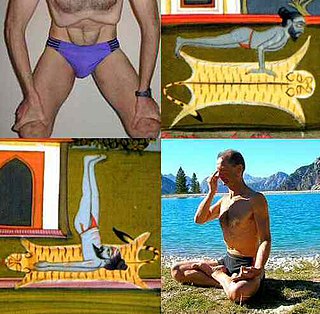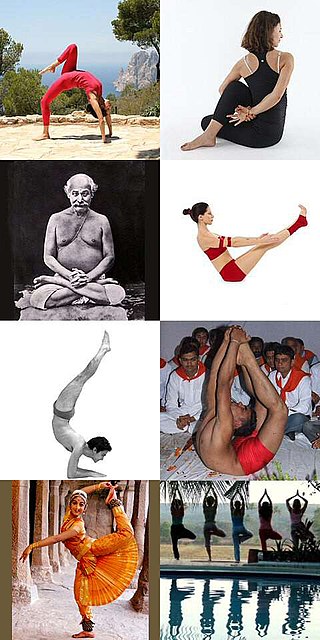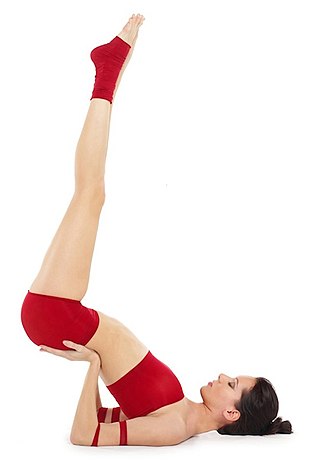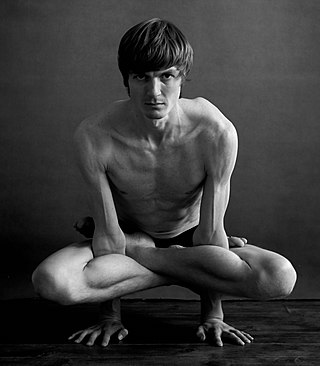
Hatha yoga is a branch of yoga which uses physical techniques to try to preserve and channel the vital force or energy. The Sanskrit word हठ haṭha literally means "force", alluding to a system of physical techniques. Some hatha yoga style techniques can be traced back at least to the 1st-century CE, in texts such as the Hindu Sanskrit epics and Buddhism's Pali canon. The oldest dated text so far found to describe hatha yoga, the 11th-century Amṛtasiddhi, comes from a tantric Buddhist milieu. The oldest texts to use the terminology of hatha are also Vajrayana Buddhist. Hindu hatha yoga texts appear from the 11th century onwards.

An āsana is a body posture, originally and still a general term for a sitting meditation pose, and later extended in hatha yoga and modern yoga as exercise, to any type of position, adding reclining, standing, inverted, twisting, and balancing poses. The Yoga Sutras of Patanjali define "asana" as "[a position that] is steady and comfortable". Patanjali mentions the ability to sit for extended periods as one of the eight limbs of his system. Asanas are also called yoga poses or yoga postures in English.
In Sanskrit texts, Rāja yoga was both the goal of yoga and a method to attain it. The term also became a modern name for the practice of yoga in the 19th-century when Swami Vivekananda gave his interpretation of the Yoga Sutras of Patanjali in his book Raja Yoga. Since then, Rāja yoga has variously been called aṣṭāṅga yoga, royal yoga, royal union, sahaja marg, and classical yoga.

The Haṭha Yoga Pradīpikā is a classic fifteenth-century Sanskrit manual on haṭha yoga, written by Svātmārāma, who connects the teaching's lineage to Matsyendranath of the Nathas. It is among the most influential surviving texts on haṭha yoga, being one of the three classic texts alongside the Gheranda Samhita and the Shiva Samhita.

Gheranda Samhita is a Sanskrit text of Yoga in Hinduism. It is one of the three classic texts of hatha yoga, and one of the most encyclopedic treatises in yoga. Fourteen manuscripts of the text are known, which were discovered in a region stretching from Bengal to Rajasthan. The first critical edition was published in 1933 by Adyar Library, and the second critical edition was published in 1978 by Digambarji and Ghote. Some of the Sanskrit manuscripts contain ungrammatical and incoherent verses, and some cite older Sanskrit texts.

Dhanurasana is a back bending asana in hatha yoga and modern yoga as exercise.

Siddhasana or Accomplished Pose, is an ancient seated asana in hatha yoga and modern yoga as exercise suitable for meditation. The names Muktasana and Burmese position are sometimes given to the same pose, sometimes to an easier variant, Ardha Siddhasana. Svastikasana has each foot tucked as snugly as possible into the fold of the opposite knee.

Viparita Karani or legs up the wall pose is both an asana and a mudra in hatha yoga. In modern yoga as exercise, it is commonly a fully supported pose using a wall and sometimes a pile of blankets, where it is considered a restful practice. As a mudra it was practised using any preferred inversion, such as a headstand or shoulderstand. The purpose of the mudra was to reverse the downward flow of vital fluid being lost from the head, using gravity.
Shiva Samhita is a Sanskrit text on yoga, written by an unknown author. The text is addressed by the Hindu ascetic Shiva to his consort Parvati. The text consists of five chapters, with the first chapter a treatise that summarizes nondual Vedanta philosophy with influences from the Sri Vidya school of South India. The remaining chapters discuss yoga, the importance of a guru (teacher) to a student, various asanas, mudras and siddhis (powers) attainable with yoga and tantra.

Vajrasana, Thunderbolt Pose, or Diamond Pose, is a kneeling asana in hatha yoga and modern yoga as exercise. Ancient texts describe a variety of poses under this name.

Kukkutasana, Cockerel Pose, or Rooster Posture is an arm-balancing asana in hatha yoga and modern yoga as exercise, derived from the seated Padmasana, lotus position. It is one of the oldest non-seated asanas. Similar hand-balancing poses known from the 20th century include Pendant Pose or Lolasana, and Scale Pose or Tulasana.

Yoganidrasana, or Yogic Sleep Pose is a reclining forward-bending asana in modern yoga as exercise. It is sometimes called Supta Garbhasana. The name Dvi Pada Sirsasana is given to the balancing form of the pose.
The Haṭha Ratnāvalī is a Haṭha yoga text written in the 17th century by Srinivasa. It is one of the first texts to name 84 asanas, earlier texts having claimed as many without naming them. It describes 36 asanas.
The Joga Pradīpikā is a hatha yoga text by Ramanandi Jayatarama written in 1737 in a mixture of Hindi, Braj Bhasa, Khari Boli and forms close to Sanskrit. It presents 6 cleansing methods, 84 asanas, 24 mudras and 8 kumbhakas. The text is illustrated in an 1830 manuscript with 84 paintings of asanas, prepared about a hundred years after the text.
The Haṭhābhyāsapaddhati is a manual of Haṭha yoga written in Sanskrit in the 18th century, attributed to Kapāla Kuraṇṭaka; it is the only known work before modern yoga to describe elaborate sequences of asanas and survives in a single manuscript. It includes unusual elements such as rope poses.

The Bahr al-Hayāt or Ocean of Life is an illustrated Persian book, published c. 1602 by Muhammad Ghawth, which covers topics including asanas used for meditation. It is probably the first illustrated textbook of yoga.
Vajroli mudra, the Vajroli Seal, is a practice in Hatha yoga which requires the yogin to preserve his semen, either by learning not to release it, or if released by drawing it up through his urethra from the vagina of "a woman devoted to the practice of yoga".

Props used in yoga include chairs, blocks, belts, mats, blankets, bolsters, and straps. They are used in postural yoga to assist with correct alignment in an asana, for ease in mindful yoga practice, to enable poses to be held for longer periods in Yin Yoga, where support may allow muscles to relax, and to enable people with movement restricted for any reason, such as stiffness, injury, or arthritis, to continue with their practice.
Jason Birch is a scholar of medieval hatha yoga and a founding member of SOAS's Centre for Yoga Studies.













